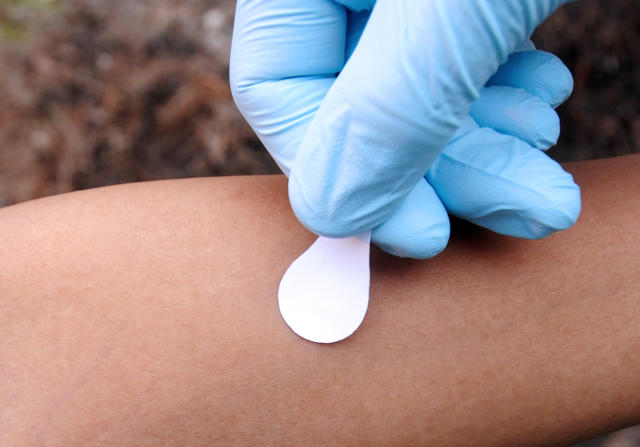Most people hate getting jabbed with even a single needle, but Georgia Tech's Mark Prausnitz thinks the future of vaccination is to jab people with a hundred needles at once. But it's not as terrifying as it sounds; in fact, Praustnitz's design for delivering vaccines is as easy as slapping on a band-aid.
Just a fraction of a millimeter long, up to 100 microneedles can be applied at once to painlessly vaccinate patients against the flu, rubella, or the measles. Using a cocktail of sugar, vaccine, and a polymer (to keep the needles stable), each patch contains a single dose of vaccine. To apply it, you just slap it onto someone's skin like a sticker. The tiny needles then painlessly puncture a patient's skin, where they dissolve. 20 minutes later, and you can throw the patch away, fully vaccinated.
Although needles are most effective way of vaccinating someone, they have a lot of problems, especially in the developing world. Not only do they hurt, but require special training to mix and administer the vaccine, which itself requires refrigeration to keep viable, says Dr. James Goodson of the Center for Disease Control.

Conversely, the patch requires no training to apply, no refrigeration to keep the medicine viable, and early cost estimates say that it will be no more expensive than a traditional vaccine, which in the case of measles and rubella is about $1.30 per dose.
That's why the CDC is so interested in Prausnitz's technology, which it is currently working (along with the Bill and Melinda Gates Foundation) to implement into measles and rubella vaccines, and is on schedule to begin human trials in 2017. Although the CDC is trying to eradicate measles and rubella by 2020, 145 thousand people a year still die of these easily preventable diseases.
"Measles vaccination rates have stagnated at around 84% over the last five years," Goodson tells Co.Design. "We think innovations like the microneedle vaccination patch will help us get over the hump."
But the microneedle patch isn't only for measles and rubella. Prausnitz tells me that they've tested the technology with a dozen different vaccines so far. Georgia Tech is even working with the National Institute of Health to develop a flu version of the microneedle patch, which is even further along than the measles and rubella version: it's undergoing clinical trial this year. "I think people will start seeing these patches during flu season in the next three to five years," Prausnitz says.

Both Prausnitz and the CDC think the microneedle patch has a good chance of saving a significant number of lives in the developing world. Asked, though, if microneedle patches could help woo over America's anti-vaxxers, Prausnitz seemed skeptical.
"If you think, against all evidence, that getting a vaccination is dangerous, the microneedle patch won't change your mind," Prausnitz says. "But if you're not vaccinated because you're scared of needles, or don't want to have to make a trip to the doctor, the microneedle patch could help."
And is the microneedle patch really painless? "Patients feel like something is being pressed into their skin, but they don't find it objectionable," Prausnitz says. "Pain isn't a word anyone has used, although it's hard to describe the sensation exactly." You just have to try it for yourself.
Read Georgia Tech's press release about the microneedle patch here.